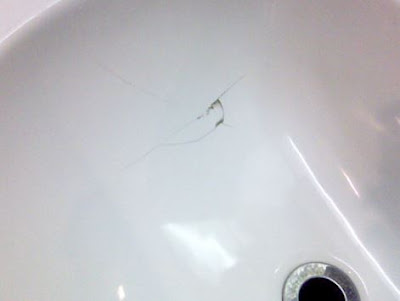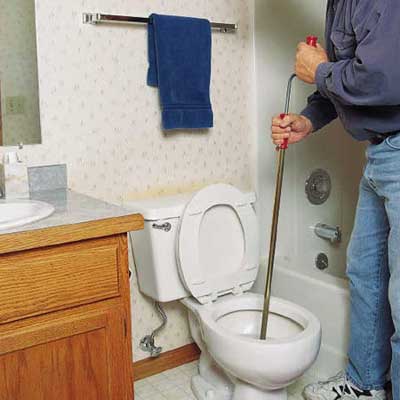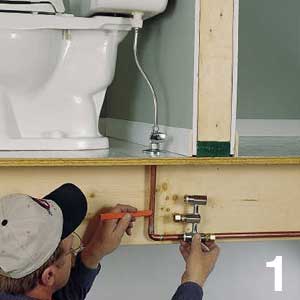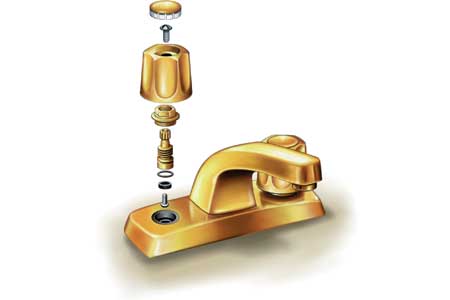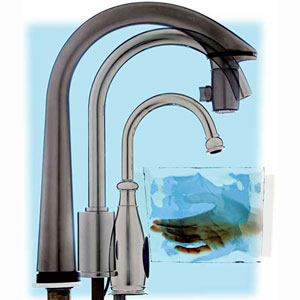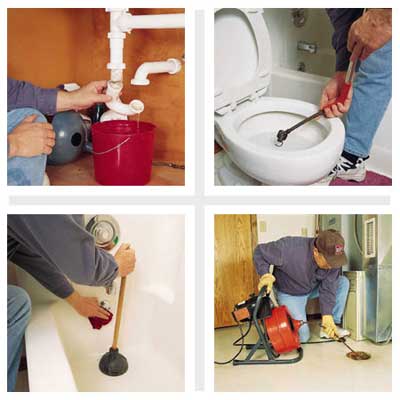
Roto-Rooter reports
that that day after Thanksgiving is the single busiest day of the year for
their service technicians. Armed with the right tools and techniques, you can
easily unplug stopped-up drains without having to call in a pro. All plumbing
systems develop clogs—there's no way to avoid it. We'll show you how to clear
stubborn clogs in a kitchen sink, bathtub, toilet and floor drain. These proven
techniques will dislodge virtually any clog. If you can't clear a clog after a
few attempts, make sure you admit defeat and turn the job over to a
drain-cleaning service or licensed plumber. Exerting too much force can
permanently damage a pipe or fixture.
That said, specialized plumbing tools used to combat clogs are affordable, and
they're available at any hardware store or home center; you can even rent some.
• The first tool to reach for when trouble arises is aplunger. This plumber's
friend clears clogs from most fixtures, including sinks, tubs and toilets.
Every homeowner should keep one handy.
• To dislodge clogs located farther down the drainpipe, use a cable auger,
or plumber's snake, a long, flexible steel cable wound around a spool
that's fitted with a hand crank. Cable augers are available in lengths up to
100 feet, though a 25-foot model will suffice for most any household clog.
• A closet auger is specifically made for snaking out toilets. It,
too, is equipped with a hand crank, but instead of a spool, the cable is
encased in a rigid shaft. The auger end is bent at a precise angle to fit
through the tight curves of a toilet trap.
• For a very large clog or one that's far from the fixture, rent an electric
power auger. This machine—basically a large cable auger powered by an electric
motor—is very effective at cutting through virtually any clog, even tangled
tree roots. Before bringing home a power auger, be sure the rental agent shows
you how to safely dispense and retrieve the cable.
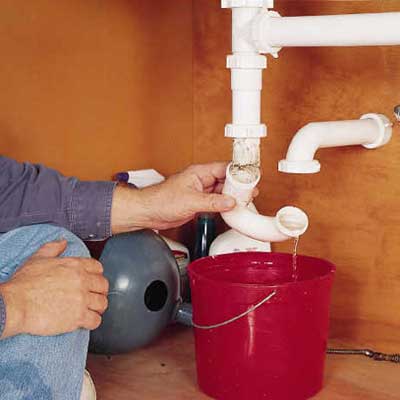
Most minor sink clogs can be cleared with a plunger.
Partially fill the sink with water, then start plunging. Vigorously work the
plunger up and down several times before quickly pulling it off the drain
opening. If it's a double-bowl kitchen sink, stuff a wet rag into one drain
opening while you plunge the other one. If it's a bath sink, stuff the rag into
the overflow hole. In both cases, the rag helps deliver the pressure directly
to the clog.
If plunging doesn't work, grab the cable auger and go to work under the sink.
Remove the sink trap with a pipe wrench. The large, threaded coupling on PVC
plastic traps can often be unscrewed by hand. Empty the water from the trap
into a bucket, then make sure the trap isn't clogged.
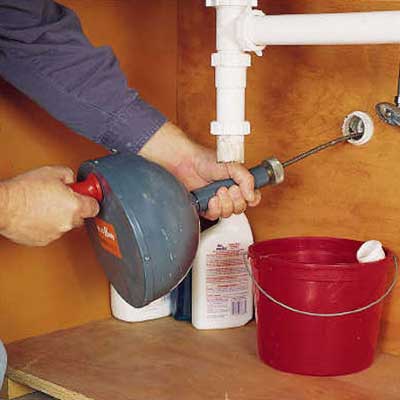
Remove the horizontal trap arm that protrudes from the
stubout in the wall. Feed the cable into the stubout until you feel resistance.
Pull out 18 inches of cable, then tighten the lock screw. Crank the handle in a
clockwise direction and push forward at the same time to drive the cable farther
into the pipe .
Pull out another 18 inches of cable and repeat the process until you break
through the blockage. If the cable bogs down or catches on something, turn the
crank counterclockwise and pull back on the auger.
Once the cable is clear, crank and push forward again.
Retrieve the cable and replace the trap arm and trap. Turn on the hot-water
faucet to see if the sink drains properly. If it doesn't, don't worry. Debris
from the busted-up clog sometimes settles into a loose blockage. Partially fill
the sink with hot water and use the plunger to clear the debris. Follow up with
more hot water.
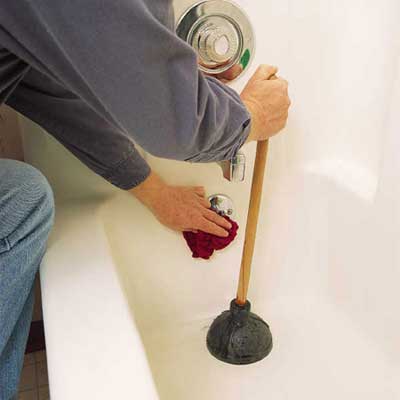
It's rare for a bathtub to suddenly become stopped up. A
clog in the tub usually builds up over a period of several weeks, with the tub
draining more and more slowly each day. We've all seen this happen.
As with a sink clog, start with the plunger. First, unscrew the screen from the
tub drain and use a bent wire to fish out any hair and soap scum. If there's a
pop-up drain on the tub, raise the lever to the open position, then grab the
stopper and pull it from the drain hole. Clean it of all hair and soap. This
will often take care of things.
If not, cover the holes on the underside of the overflow plate with a wet rag
and start plunging. If that doesn't clear the clog, use the cable auger.
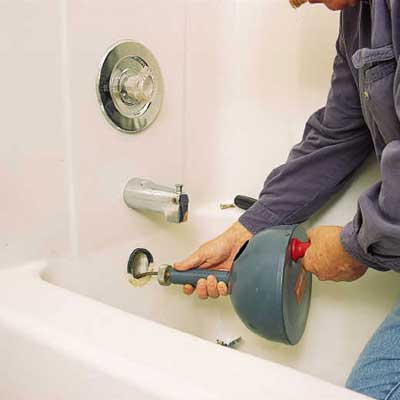
Remove the overflow plate from the end of the tub; the
stopper linkage will come out with it. Feed about 30 inches of cable down the
overflow tube. Push forward while turning the hand crank. You'll feel resistance
almost immediately, but keep cranking on the auger until the cable passes all
the way through the P-trap that lies underneath the tub.
Retrieve the cable, then run several gallons of hot water down the drain.
Finally, replace the overflow plate and screen or pop-up drain.
Toilet clogs almost always occur at the top of the tight,
up-curving trap that's part of the fixture. In some cases, a plunger can
provide enough power to clear the way, but more often than not, you'll have to
use a closet auger.
Place the auger end into the bowl with its bent tip aiming up.
Hold the tool shaft steady as you crank and push down on the
handle. You'll feel the cable snake its way up and through the trap.
Continue cranking until you've dispensed the entire cable—about 3 feet.
Retrieve the cable by simultaneously cranking and pulling up.
Flush the toilet to clear out the drainpipe. If it's still a little sluggish,
run the auger through the trap twice more: once up the left side of the trap,
then again up the right side. This three-pronged attack will clear any matter
clinging to the sides of the trap.
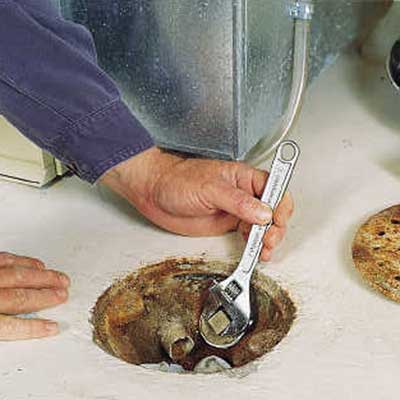
In many basements, garages and laundry rooms there are floor
drains that carry away wastewater from central air conditioners, washing
machines, water heaters and snow-covered cars.
Over time, these drains collect large quantities of soap scum, laundry lint,
sand and slimy bacteria that crystallize inside the long drainpipe. To break
through these tough blockages, you'll need the extra clog-clearing muscle of an
electric power auger.
Rent a power auger with at least 50 feet of cable. Start by removing the
strainer that covers the drain hole. Then, look for a clean-out plug on the
side of the drain basin. Remove the plug with a wrench. That allows you to
bypass the trap and feed the cable directly down the pipe. If the drain doesn't
have a clean-out plug, you'll have to snake the cable through the trap; this is
a somewhat more difficult approach.
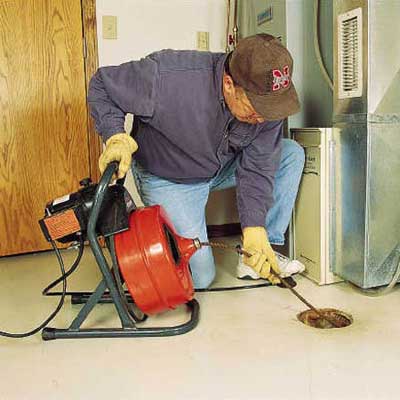
Plug in the power auger and position it near the drain. Most
models are fitted with a foot-pedal switch, leaving both of your hands free to
guide the cable. Feed several feet of cable down the drainpipe. Set the motor
for clockwise rotation, then step on the switch to start the cable turning.
Push the cable into the pipe until you feel resistance or hear the motor start
to bog down. Stop the motor, reverse the rotation and back out a few feet of
cable. Switch back to clockwise rotation and feed the cable farther down the
pipe. Repeat this back-and-forth procedure until the clog has been cleared
away.
Retrieve the cable and flush out the drainpipe by pouring several buckets of
hot water down it. If the water still drains sluggishly, run about 2 feet of
cable directly down the trap.
Before replacing the clean-out plug, wrap Teflon tape around its threads; this
will make it easier to unscrew the plug in the future. Caution: Failure to
replace the clean-out plug will allow dangerous sewer gases to seep into the
house.
source:
http://www.thisoldhouse.com/toh/photos/0,,20360498,00.html
by Merle Henkenius
http://www.guaranteedplumbingco.com

